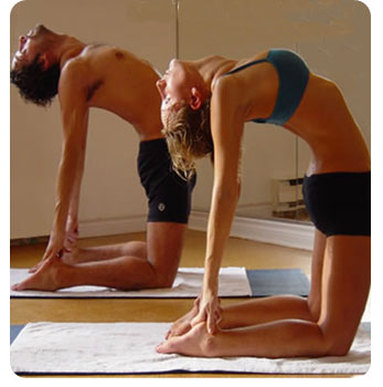 How Yoga Can Help Your Lower Back Pain
By Sarah Court www.exercise.comBack pain has become an epidemic in the US. 80 percent of the population will report back pain at some point in their lives, and we spend about $16 billion a year to treat it. Pain in the low back is especially common for many reasons, some of which are outlined below. Can yoga help with this pain? Absolutely. Low Back StructureWhat is it about the structure of the lower back that would put it at such particular risk for pain? Some of it has to do with the shape of the spinal bones, or vertebrae. The spine is made up of 24 vertebrae, plus a sacrum and a coccyx (tailbone). Those 24 vertebrae all have different shapes in relation to the bones above and below, and this means they will have more or less movement available, depending on what part of the spine they are in. For example, the cervical spine, also known as the neck, is extremely mobile in many directions, but the thoracic spine (where your ribs are) is not (and for good reason: there are important organs in there, like your heart and your lungs). The lumbar spine, also known as your lower back, is also very mobile like the neck, but at the same time it supports the weight of the rest of the torso. This makes it especially prone to injury; if we overstretch the muscles, and then bear too much weight (say, bending over to pick something up) this can put too much pressure on the low back as a result. What Causes Low Back Pain?In addition to the structure of the back, there are other parts of the body that might contribute to pain in the lower back as a result of our daily habits. Sitting for a long time in a car, or at a desk, will tighten the hamstrings on the back of the thighs, and tight hamstrings set up a line of pull into the buttock muscles and into the low back. When we sit with our upper body hunched forwards, it pulls on the muscles of the lower back, which can then become stuck that way, or "locked long." These muscles then have a very hard time contracting again, which can lead to discomfort. These are just a few possible reasons—there are certainly more. How Does Yoga Help?Beginning a yoga practice will help to clear up some of the muscular issues addressed above—the hamstrings will get a chance to stretch, and the back will get to contract properly and regain its essential tone. In addition, strength and flexibility will be brought to the rest of the body, and there will be a greater integration of all musculature as it works together to support you! Sarah Court is a featured Yoga Columnist on Exercise.com where she writes about yoga, fitness and exercise. She teaches weekly Yoga Tune Up® and Vinyasa classes at various locations in Los Angeles, and trains yoga teachers in anatomy and in Yoga Tune Up® across the country. She's been featured in the New York Times and as one of nursingschool.net's 100 Incredible Yoga Teachers Who Blog.
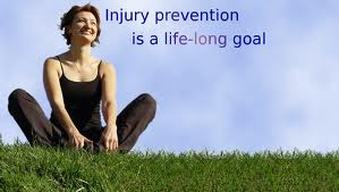 My topic for this Fitness Journal entry is about Fitness Injury Prevention. It's become apparent in multiple conversations I've had this past week; more often than not people are getting injured repeatedly while trying to better their health. The truth is these are people that have had proper fitness direction, people that are just getting started on their fitness journey, and people that are just plain pushing themselves to hard to fast. It doesn't matter the fitness level your starting at that determines if your going to get injured or not, it's the amount of preparation for the level of fitness, that determines if you get injured. It's fact that we all will get some form of injury at some point in our fitness journey, but the most important thing is to realize that prevention of injuries is simple and a life-long goal. You will never get to a point in your fitness journey that stretching and properly warming up shouldn't be your first priority before working out. I'm sure I'm not alone when I see lots of people enter the gym and going straight to working out without warming up or doing any form of stretching. Yes, I will come clean and say I have been one of those people, but have realized the hard way (the painful way) of the importance of warming up and stretching. I'm not getting any younger that's for sure, but by taking care of myself I can feel younger. I'm a great example of constant injuries that are hindering my fitness goals. It all started with my lower back and a pinching of my Sciatic Nerve, which for the most part limited me from almost every kind of physical activity. Second, it was a calcium deposit in my left shoulder that when I lifted my arm cause unforgiving pain. Third it was re-occurring inflammation in my right knee that kept me sidelined from almost every kind of cardio and knee bending exercises. Fourth it was my lower back and hip joint that limited my mobility to preform even simple athletic tasks. The point here is that all of these injuries could have been prevented by me. I was ambitious but not cautious. Under the care of Dr. Ryan Nienaber I have been educated that my lower back pain is due to a weak and unconditioned hamstring and underlying muscles in the hip joint. My back pain flares up when I over due any kind of squatting motion. So now I'm slowing down and doing more and more squatting endurance workouts to help build up and strengthen those muscles. More like a therapy kind of workout. As for my knee well it's just as simple. As long as I keep my Quadricep muscle stretched and proper warmed I don't have any pain or discomfort. I have been able to manage most of the pain in my shoulder by doing higher intensity type workouts, like flat, inclined and declined pushups to failure. These workouts are proving to help build the supportive muscles and connective tissues, not to mention being a huge stabilizer for the chest workouts. I am the first person to say that ICE is your friend. Yes the frozen water in your freezer. When your over ambitious and over-eager to see results we tend to temporarily push our bodies to a point of no return. When we were younger we could push hard each and everyday and only suffer mild OMS ( Onset Muscle Sorness). As we age we realize that our bodies start having a louder voice when we overdue it. Our hangovers from that third glass of wine, or the grueling squat workout just hits us harder and harder the older we get. So it's very important that we all stop and make a game plan for our future in fitness and make choices that will allow us to grow and progress and not put us in a state of neglect and dormancy. As Adults we need to make choices to better our health and by doing so we become the most powerful role-model to our children and children's children. I was reading a blog posting today from Abby Rike former contestant of the Biggest Loser and motivational speark; who said one of the most motivational things you can do is seek a group that will keep you active or find a online forum where it's possible to receive and share fitness advice. Read more at www.abbyrike.comIt's important we aren't alone in our fitness journey, being healthy isn't easy and well very much a day to day challenge for most. Don't be afraid to share your story with others, listen and share the knowledge you've gained so far in your fitness journey. The only way were going to make America a better place is by improving the health of the future, our kids. We are the role models and we must fight for a better life for today and tomorrow. Start now by doing something productive and encourage your kids to be active, eat healthier and most importantly build their self esteem by giving them motivational compliments. Do the work, run the miles, and cherish each moment as our gift of life. Make a commitment to get outside by yourself and with your kids for at least 15 minutes a day of some form of physical activity. Go for a walk, hike next to the river, ride your bikes, kick the soccer ball, etc. Doesn't matter just be involved with creating a habit and you and your kids will reap the rewards of a higher self esteem, more confidence , better eating habits and good ole happiness. Good luck and remember you must BELIEVE TO RECEIVE....
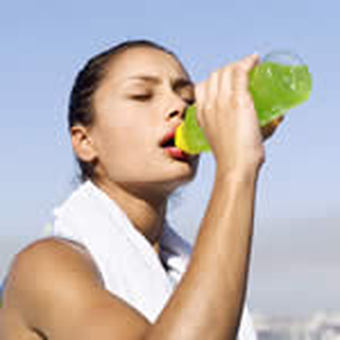 By Matt Fitzgerald
For Active.com
Unless you've been living in a cave, you've probably seen those television advertisements in which a leading sports drink maker claims its product "hydrates better than water." The fact that the message of these ads hasn't changed in many years suggests that a lot of athletes aren't buying it. But it's actually true.Why do sports drinks hydrate better than water? There are three reasons. First, fluids are absorbed through the gut and into the bloodstream faster when their osmolalityclosely matches that of body fluids such as blood.
Osmolality is the concentration of dissolved particles in a fluid. Sports drinks contain dissolved minerals (sodium, etc.) and carbohydrates, whereas water doesn't, so water doesn't reach the bloodstream as quickly.
Sodium and other nutrients also play important roles in regulating fluid balance in the body. In other words, they help determine how much fluid enters into muscle fibers and other cells, how much remains in the blood, and so forth. Again, because sports drinks contain these nutrients, they do a better job of allowing the body to maintain optimal fluid balance, which is an important aspect of hydration that few athletes consider.
A third advantage of sports drinks over water with respect to hydration is that the sodium content of sports drinks stimulates thirst, so athletes usually drink more when they have a sports drink than when they have plain water.
Choosing the Right Sports Drink
Not all sports drinks hydrate equally. Those that contain higher amounts of sodium are preferable, because they are absorbed quicker and maintain fluid balance in the blood and muscles better. Choose a sports drink that contains at least 15 mg of sodium per ounce.
New research suggests that sports drinks containing a small amount of protein may also hydrate better than conventional sports drinks. Protein is an often-overlooked nutrient that affects osmolality just as minerals and carbs do. Therefore the addition of protein to a sports drink has the potential to increase its absorption rate.
This was demonstrated in a recent study by exercise physiologists at San Antonio Catholic University in Murcia, Spain, and published in the Spanish Journal of Nuclear Medicine.
Twenty-four well-trained cyclists participated in the study. They were fed either of two sports drinks at rest and during a workout. Drink A was a conventional sports drink containing 15 grams of carbohydrate per 100 ml. Drink B contained 10 grams of carbohydrate per 100 ml plus proteins.
After 60 minutes of exercise, the researchers found that a significantly greater amount of drink B, containing carbs and protein, had been absorbed than drink A. These results indicate that a carb-protein sports drink may hydrate better than a conventional sports drink.
The addition of protein to a sports drink appears also to aid fluid retention. When a beverage is too dilute, it tends to pass quickly through the bloodstream to the bladder so it doesn't "water down" the blood and other body fluids.
New evidence suggests that the right amount of protein in a sports drink, in combination with the right amount of carbs and electrolytes, may boost fluid retention and help you hydrate better during exercise.
In a new study from St. Cloud State University, cyclists exercised until they lost two percent of their body weight and then consumed one of three beverages: a sports drink containing carbohydrate and protein in a 4:1 ratio; a conventional sports drink containing carbs and electrolytes but no protein; or water.
Over the next three hours, the investigators measured how much of each beverage was retained. Only 53 percent of the water was retained, versus 75 percent of the conventional sports drink and an amazing 88 percent of the carb-protein sports drink.
Other Advantages of Sports Drinks
Sports drinks have other advantages over water for athletes and exercisers that go beyond better hydration. Specifically, the calories in sports drinks have been shown to increase energy and endurance, limit the immune system suppression that sometimes follows hard workouts, reduce exercise-induced muscle damage, and promote faster recovery.
Water is by far the most popular fluid choice during exercise. However, sports drinks actually do a better job of hydration, while also providing other benefits that water does not. Water is a great drink choice outside of workouts, but during exercise you're much better off with a sports drink. In this case, there's truth in advertising.
This article was adapted by the author from The Cutting-Edge Runner: How to Use the Latest Science and Technology to Run Longer, Stronger, and Faster (Rodale). Clickhere to purchase a copy. http://www.active.com/running/Articles/Which_fluid_hydrates_best__Water_or_a_sports_drink_.htm?cmp=17-7-313
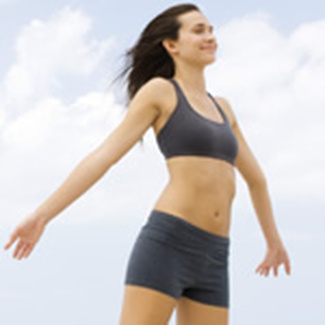 By Cathy Garrard
Prevention
You know exercise makes you feel good. Why not feel great? Harnessing—and maximizing—the restorative powers of your workout can send your mood soaring and get you psyched for tomorrow's session.Prevention pored over the research and consulted experts, including PhDs and even a hypnotist, to find easy, effective strategies to keep you revved long after you've unlaced your walking shoes.
Drink Caffeine
This stimulant doesn't just give you the energy to start your workout: New research suggests that it may help you feel better once you're done, too. Women who consumed the equivalent of 2 1/2 cups of coffee an hour before a 30-minute bike ride reduced leg muscle pain by nearly half, compared with those who didn't have caffeine, according to a study published in Medicine & Science in Sports & Exercise. Caffeine appears to work on the inflammatory agent known as adenosine.
"It may block the chemical from binding to brain or muscle receptors associated with pain," says lead researcher Robert Motl, Ph.D., an assistant professor of kinesiology and community health at the University of Illinois at Urbana-Champaign. Even just a cup of joe might add some oomph to your moves while easing pain.
Use Your Nose
Stimulating scents wake up your brain and body, suggests a study at Wheeling Jesuit University. Athletes who walked on a treadmill for 15 minutes while inhaling a peppermint aroma felt more invigorated afterward than those who walked without smelling anything.
"Peppermint increases brain activity in areas that heighten alertness," says lead researcher Bryan Raudenbush, Ph.D., an associate professor of psychology. The rejuvenating scent can also help enhance your workout so you experience that natural high faster. Although sniffing peppermint produces the best results, you can get a boost from flavored gums, mints, or a beverage such as Metromint water.
Another feel-good fragrance? Jasmine. Raudenbush says inhaling the sweet aroma after exercise helps your heart rate and blood pressure return to normal more quickly as you cool down, allowing your body to recuperate faster from a tough workout.
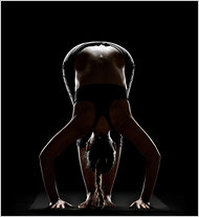 By GRETCHEN REYNOLDSWe all know that physical activity is beneficial in countless ways, but even so, Dr. Mark Tarnopolsky, a professor of pediatrics at McMaster University in Hamilton, Ontario, was startled to discover that exercise kept a strain of mice from becoming gray prematurely.
Getty ImagesBut shiny fur was the least of its benefits. Indeed, in heartening new research published last week in The Proceedings of the National Academy of Sciences, exercise reduced or eliminated almost every detrimental effect of aging in mice that had been genetically programmed to grow old at an accelerated pace.
In the experiment, Dr. Tarnopolsky and his colleagues used lab rodents that carry a genetic mutation affecting how well their bodies repair malfunctioning mitochondria, which are tiny organelles within cells. Mitochondria combine oxygen and nutrients to create fuel for the cells — they are microscopic power generators.
Mitochrondria have their own DNA, distinct from the cell’s own genetic material, and they multiply on their own. But in the process, mitochondria can accumulate small genetic mutations, which under normal circumstances are corrected by specialized repair systems within the cell. Over time, as we age, the number of mutations begins to outstrip the system’s ability to make repairs, and mitochondria start malfunctioning and dying.
Many scientists consider the loss of healthy mitochondria to be an important underlying cause of aging in mammals. As resident mitochondria falter, the cells they fuel wither or die. Muscles shrink, brain volume drops, hair falls out or loses its pigmentation, and soon enough we are, in appearance and beneath the surface, old.
 Madeline Romeo
For Active.com
Losing sleep is certainly not something to be taken lightly. If lack of sleep tends to happen more often than not, our body is no longer able to function normally.
Research shows that lack of sleep affects your body's ability to lose weight, impair yourconcentration and even mimic the symptoms of impaired glucose tolerance (which can lead to diabetes and hypertension).
Your mood also suffers when you don't get enough sleep, causing you to become disoriented on the job, fatigued behind the wheel or irritated at home. More importantly, these mood swings can affect your relationships with others and even lead to depression.
There is good news, you can improve the quality and quantity of yoursleep starting tonight. Here are six tips to get a good night's sleep.
- Your Sleep EnvironmentCreate an environment that is just for sleeping. Avoid sitting in bed to pay your bills, do work, watch television, eat, talk on the phone or other distractions. Your mind will expect that the bedroom is for daytime activities. Use soft lighting, comfortable bedding and turning the clock away from your view.
- Develop a RoutineSet a time to get in bed and stick with it. Eventually your body will get used to going to sleep at that time and it will begin to come naturally.
- Limit Your Food and Beverages Before BedAs you lie down to sleep, acids in the stomach level out, your metabolism increases slightly to digest food, which can also raise your energy level. Stop eating at least three hours before your scheduled bedtime. If you must snack on something, keep it small, and avoid high-fat foods, which take longer to digest. Alcohol may be a depressant, but after its sedative effects wear off, your sleep patterns will suffer.
- A Breathing ApproachFocus on your breathing will clear your mind and relax the body.
- Know When and How to NapIf you are looking for some rest during the day, try to limit your nap to about 20 minutes. This will allow the body to rest mid-day and still be able to get to sleep at night.
- Take Control of Your ThoughtsTry to decrease your brain activity before bed by writing down your thoughts in a journal and closing the book on the day. If thinking keeps you up at night, deal with those thoughts (pay the bill that you are worried about forgetting, make a to-do list, etc.), and come back to bed when you're ready to sleep.
Madeline Romeo is a Certified Personal Trainer, Corrective Exercise Specialist, and Child Birth Educator. She is a marathon runner and triathlete. She started as an Athletic Trainer for college athletes in 2000 and moved to coaching and personal training in 2006. Her motto: "We all need that person who can see our strengths and abilities, and can push us further than we can push ourselves."www.MobileWorkoutSD.com
http://www.active.com/mindandbody/articles/6-tips-to-a-good-nights-sleep.htm?cmp=17-7-262
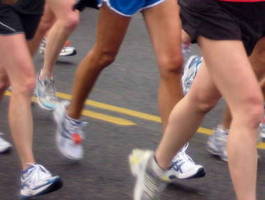 With spring right around the corner-and so many events-I thought it was time for me to remind you about some running basics that might keep you from getting injured along the way; the most common injury being knee pain.
My clients have reminded me that three of the many things required for running without knee pain, particularly in distance training, are a good base, the right shoes and the proper cadence.
The knee pain I am concerned with is at the lower outside front of the knee. (Read more about this type of injury, commonly called "Runner's Knee" inRunOregon's five-part series about what Runner's Knee is and what to do if you have it.) It hurts during the run and gets worse as you run, and stops once you stop. I have had this type of irritation. My first prognosis is the shoe. Blame the shoe because it is a good
sign that your shoes are starting to need replacement, and for many runners this is true.
|








 RSS Feed
RSS Feed







